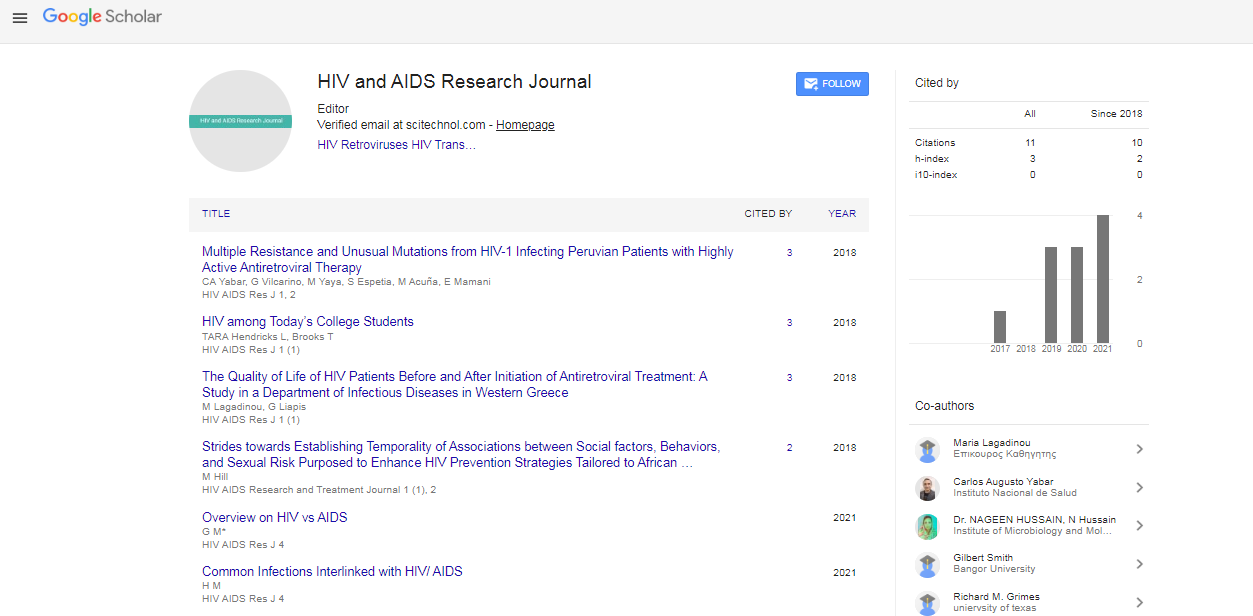Opinion Article, J Phys Res Appl Vol: 6 Issue: 1
Emerging Perspectives on Acute HIV Infection and its Detection
Andrew Reiss*
Discipline of Public Health Medicine, University of KwaZulu-Natal, Durban, South Africa
*Corresponding Author: Andrew Reiss
Discipline of Public Health Medicine,
University of KwaZulu-Natal, Durban, South Africa
E-mail: andrewreiss33@gmail.com
Received date: 20 February, 2023, Manuscript No. HARJ-23-94889;
Editor assigned date: 22 February, 2023, PreQC No. HARJ-23-94889 (PQ);
Reviewed date: 09 March, 2023, QC No HARJ-23-94889;
Revised date: 16 March, 2023, Manuscript No. HARJ-23-94889 (R);
Published date: 23 March, 2023, DOI: 10.4172/Harj.1000122
Citation: Reiss A (2023) Emerging Perspectives on Acute HIV Infection and Its Detection. HIV AIDS Res J 6:1.
Description
Human immunodeficiency virus (HIV) infection remains a global health concern, with millions of new infections reported each year. While HIV is a chronic infection that progresses over time, the acute stage of HIV infection is vital and often overlooked phase that plays an important role in the transmission, diagnosis, and management of the disease. Acute HIV infection, also known as primary HIV infection or acute retroviral syndrome, refers to the early stage of HIV infection that occurs immediately after a person contracts the virus. This stage is characterized by a high level of viral replication in the body, resulting in a rapid decline in CD4+ T cells, which are essential for immune function. Acute HIV infection is typically marked by the presence of HIV RNA, the genetic material of the virus, in the blood, and the absence or low levels of HIV antibodies, which are typically detected in later stages of infection.
The clinical presentation of acute HIV infection varies among individuals and can mimic symptoms of other viral illnesses, making it difficult to diagnose. Common symptoms of acute HIV infection may include fever, fatigue, headache, muscle and joint pain, swollen lymph nodes, sore throat, rash, and oral ulcers. These symptoms are often nonspecific and may resolve spontaneously, leading to under diagnosis or misdiagnosis of acute HIV infection. However, some individuals may experience more severe symptoms, including neurological manifestations, such as meningitis or encephalitis.
Diagnosing acute HIV infection can be challenging due to several factors. First, the nonspecific nature of the symptoms can lead to misdiagnosis or delayed diagnosis. Second, the window period, which is the time between HIV infection and the detection of HIV antibodies, can vary, and during this period, HIV antibodies may not be detectable, leading to false-negative results in antibody-based tests. Third, in some cases, the availability and accessibility of HIV RNA testing, which is the most sensitive and specific test for acute HIV infection, may be restricted. Finally, the psychological and social factors, including stigma and fear associated with HIV testing, may further impact the willingness of individuals to seek testing during the acute stage of infection.
The management of acute HIV infection involves a combination of Anti-Retroviral Therapy (ART), supportive care, and ongoing monitoring. Initiating ART during acute HIV infection has been shown to reduce viral replication, preserve immune function, and potentially impact the long-term clinical course of the infection. Understanding acute HIV infection is important for effective HIV prevention and control strategies.
During the acute stage of infection, individuals may have very high levels of virus in their blood, making them highly infectious and capable of transmitting the virus to others. Identifying and diagnosing acute HIV infection promptly can facilitate early initiation of antiretroviral therapy which can significantly reduce the viral load and the risk of transmission. Moreover, identifying acute HIV infections can also provide an opportunity for counselling, education, and linkage to care, including ongoing monitoring and management of the infection.
Conclusion
Acute HIV infection is a vital stage in the natural history of HIV that has significant implications for transmission, diagnosis, and management of the disease. Early identification and diagnosis of acute HIV infection can lead to improved patient outcomes, reduced transmission, and more effective public health strategies. Healthcare providers, public health agencies, and communities must be vigilant in recognizing and addressing the challenges associated with acute HIV infection to prevent the spread of this virus.
 Spanish
Spanish  Chinese
Chinese  Russian
Russian  German
German  French
French  Japanese
Japanese  Portuguese
Portuguese  Hindi
Hindi 